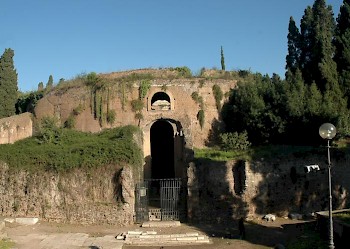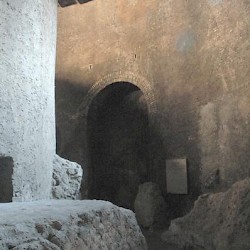Rome, Mausoleum of Augustus
Q770847Mausoleum of Augustus: the giant tomb of Rome's first emperor.

According to his contemporary, Strabo of Amasia, the tomb of the emperor Augustus was among the most remarkable monuments of Rome. The Greek geographer describes the building as an artificial hill covered with evergreen trees, and we can infer that it was not unlike the tombs in Etruria, or the tomb of Alexander the Great in Alexandria, a ruler greatly admired by Augustus. Other sources of inspiration may have been the tombs of the heroes of the Trojan War, of whom Augustus claimed to descend (e.g., the tomb of Achilles and similar monuments), and the world famous Mausoleum of Halicarnassus, the tomb of the famous satrap of Caria, Maussolus.
Strabo adds that in the neighborhood of the Mausoleum of Augustus, one could visit a park with lovely porticoes and an ustrinum (i.e., the place of the pyre) that was surrounded by black poplars. This photo to the left shows the substructure of the giant tomb itself. The outer ring has a diameter of about 89 meters and is 12 meters meters high. No Roman had ever created a tomb like this.

The upper half of this reconstruction - the photo below shows the famous model of ancient Rome in the Museo nazionale della civiltà romana - is based on the description by Strabo. He says that there was a statue of the emperor on the top. The idea that the center looked like this, is a guess based on parallels with similar monuments. It is contradicted by Strabo, who says that the monument resembled a hill.
The interior of the mausoleum consists of a square inner tomb, where Augustus and his wife Livia must have been buried, surrounded by an outer ring, where the urns of other members of the imperial family stood. The epitaph of Marcellus, who died in 23 BCE, proves that the monument was more or less finished by that time.
The exterior wall of the mausoleum of Augustus was made of brick, and covered with slabs of white travertine, exactly as described by Strabo. Next to the monument were two columns with the text of Augustus' Res Gestae (his autobiography). We do not know where these pillars stood, and how we must imagine them to have been - very large, obviously, to contain the full text.

This photo shows the mausoleum on the model in the Museo Nazionale della Civiltà Romana again: it is the big round structure at the photo's lower edge. If you draw a line from the center of the mausoleum to the obelisk of the Horologium Augusti (upper edge), and a second line from the obelisk to Augustus' Altar of Peace (Ara Pacis; the small square building in the upper left corner), you get a right-angled triangle. If there was any deeper significance to this lay-out, is not known.
In 31 BCE, Augustus (at that moment still called Octavian) had defeated his rival Mark Antony and his wife, the Egyptian queen Cleopatra VII Philopator, in the naval battle of Actium. One year after, Octavian had conquered Egypt, the last independent Hellenistic kingdom that wasn't part of the Roman Empire. Egypt's cereals were used for the food supply of Rome, which was from now on more stable.
To remind the Romans of this success, there were two obelisks in front of the entrance of the Mausoleum. Today, one of these monoliths decorates a square near the basilica of Santa Maria Maggiore. Although this obelisk looks as if it is an ancient Egyptian monument, it was in fact made for Augustus. Its height is 14.75 meters.
The other obelisk, also made by order of Augustus, is standing in front of the palace of the president of Italy, the Quirinal. It is 14.64 meters high. The two statues of Castor and Pollux date back to Antiquity too, but did not belong to the Mausoleum.
 Rome, Maria Maggiore, Obelisk |
 Rome, Mausoleum of Augustus, tombstone of Marcellus |
 Rome, Mausoleum of Augustus, tombstone of Tiberius |
 Rome, Quirinal, Obelisk |
The Mausoleum faced - although it was separated by some distance - the Pantheon, a round temple for the cult of the emperor's family, constructed by Augustus' friend Agrippa. A wide alley connected the two monuments.

A century and a half later, the Mausoleum of Augustus inspired the emperor Hadrian when he wanted to build his tomb. However, he felt free to make considerable changes to the original design. Today, the Mausoleum of Hadrian is known as the Castel Sant' Angelo.
Among the people whose ashes were buried in the mausoleum were Marcellus, Marcellus' mother (and Augustus' sister) Octavia, Augustus' friend Agrippa, Drusus, Lucius Caesar and Gaius Caesar, and Publius Quinctilius Varus. In 14, Augustus was laid to rest. Later, the ashes of Drusus the Younger, Germanicus, Drusus Caesar, Livia, Tiberius, Caligula's mother Agrippina, Nero Caesar, Caligula, Claudius, Britannicus were placed over here, together with the mummy of Nero's wife Poppaea.note Much later, the emperor Nerva and the empress Julia Domna received their tomb in the Mausoleum of Augustus.
The poet Martial wrote about this building.
Pour me a double measure, of Falernian, Callistus,
and you Alcimus, melt over it summer snows,
let my sleek hair be soaked with excess of perfume,
my brow be wearied beneath the sewn-on rose.
The Mausoleum tells us to live, that one nearby,
it teaches us that the gods themselves can die.note
 Rome, Mausoleum of Augustus, Interior |
 Rome, Mausoleum of Augustus, tombstone of Agrippina I |
 Rome, Mausoleum of Augustus, Pedestal of an urn |
 Rome, Mausoleum of Augustus, Interior |